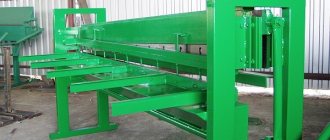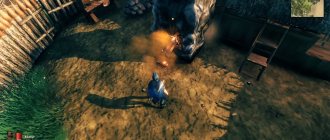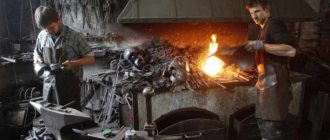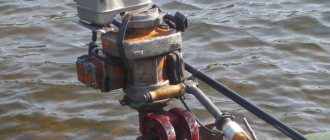Forged rose: It’s unusual, but nice to write a review about an item that will not bring you any practical use. There are many websites dedicated to welding and forging; these are popular “male” topics in RuNet. The craftsmen tell and show from the heart - some about forged chairs, others about welding seams.
But everyone has and makes their own forged roses; no one is alien to the desire for beauty and artistic creativity. Forged flowers can be made to suit every taste, but the preparation and technology for making them are the same. We read, we understand.
Preparation of materials and equipment
What materials will you need:
- Sheet metal is usually used for the petals and leaves The thickness and type of metal is a matter of taste and choice of the craftsman, but most often a sheet with an average thickness of 0.5 mm is taken. It can be cold-rolled black metal, or it can take metal from the hood or fenders of a car - it is quite thin there - up to 0.8 mm.
- For stems you need to find a suitable wire with a diameter of 5 mm or more; for options with spikes, a knitting wire with a diameter of 6 mm is more suitable - this work is more difficult. You can use rods with a diameter of 8 to 12 mm.
Forging process - drawing.
Hot forged metal roses.
Shaping the stem.
Making a flower.
The tools you will need are the simplest:
- Welding machine: better semi-automatic or inverter with 2 mm electrodes at a current of no more than 70 A.
- Grinder or grinder, metal scissors, pliers.
- Gas-burner.
- Drill with drill bits for metal from 0.5 to 1.0 cm.
- Unrefined or motor oil for finishing rose bluing.
- Metal paints, if the rose needs to be painted.
Curved gratings produced by cold forging
How can you decorate your site with imagination with your own hands? Curly bars, gates, wickets. But if you use products obtained by hot forging, then such improvement can result in a very decent amount. You can, of course, make all these structures from a 4 mm thick strip, bent using primitive devices. However, the appearance of such grilles, as well as their reliability, leave much more to be desired.
The most optimal is to use equipment that allows you to create parts from a rod with a cross-section of 1 cm x 1 cm and 1.2 cm x 1.2 cm that imitate hot forging products. The resulting products are much cheaper than hot-forged ones, but are also beautiful and reliable.
Various devices in combination with welding work make it possible to make real metal patterns using your own hands: multi-point spiral curls, a rod or strip twisted along a vertical axis, three-dimensional parts that are used in the production of “three-dimensional” gratings.
Particularly impressive is the figure obtained from square rods 6 mm x 6 mm welded together. It's called a "flashlight". Using welding, it is possible to obtain periodic “boyar” and “wave” patterns from parts bent using the “” method.
Using metal patterned parts obtained by cold forging and assembled, you can make gazebos, pergolas, decorations for porches, stairs and canopies. Such shaped metal products are perfectly combined with all architectural styles and can decorate any premises and garden plots.
DIY roses made of tin
Good afternoon, in this letter I will try to tell you the whole process of making a rose from tin, which can be an excellent gift for loved ones.
To create a rose from tin you will need a minimum of tools:
Pliers
Metal scissors
Ruler
Pencil
If possible, a compass
Tin roses step by step:
So, we will need metal mugs - you can use roofing iron or simple tin cans. We cut out circles with different diameters, approximately from 150 to 130 mm - the difference is 5 mm each, i.e. 150-145-140-135-130... You will need 5 of them - this is a blank for the flower itself.
2.
3.
Then cut out two strips approximately 2.5 cm wide. One should be 110 mm long and the other 125 mm long - this is for the inner leaves of the flower.
Then we need a star - fashionably four-pointed. We cut it out from a circle with a diameter of 110 mm - this will be the lower part of the flower.
4.
On a separate sheet of metal we draw and then cut out the leaves themselves - 1 single and one triple is enough... I think this is better... then we cut the notches along the edges of the leaves - a real appearance of a real leaf appears... and you can knock out the veins in the middle of the leaf with a simple screwdriver.
5.
Then we bend the stem of the sheet inward - with pliers... and we get a finished sheet... Here - we need another piece of wire - maybe 6 in diameter - I make these... and a piece of copper tube can be used to cut an internal thread on one side for an M6 screw - this is for in order to screw the entire assembled rose... bud... and on the other side we simply solder it into the wire.
6.
And so we cut out four-leaf flowers from circles of metal and press each leaf as shown in the photo with pliers... squeeze it into a vase and turn away the edges a little - also with pliers... then when everything is ready, insert all the baskets one into the other and edit the bends of the leaves by eye... then drill into in the middle there is a hole for a screw and twist it to the prepared tube - we solder the tube to the wire and screw the leaves with a metal strip prepared earlier... - the edges can be soldered... that's all...
7.
From these tin roses you can make anything that comes to mind - a hanger, a lamp, used to decorate a gate, etc.
A metal rose is a stylish decoration for any interior. Such a flower will never lose its attractiveness, and if made with your own hands, it will become an original gift for a loved one. Making such an unusual flower is quite simple. You just need to be patient and have the necessary tools.
Cutting without sewing, technical stages of work
The process of creating a rose:
Making a solid forged rose.
- From sheet metal we cut out four or five, if we want a larger rose, square templates with a side length of 10 cm. In each square we draw a schematic flower with four petals, try to draw them symmetrical, but precision to the millimeter is not needed here. On the last square we draw a sepal that looks like a compass rose; exact symmetry is not necessary here either.
- If you want to make a tea rose - wide open, with numerous petals, it is better not to be lazy and prepare the templates in the following order:
- The sepal is a five-pointed star with a diameter of 7–8 cm.
- The first outer blank consists of five petals with a diameter of 11 - 12 cm.
- The second and third blanks each have four petals with a diameter of 10–11 cm.
- The fourth blank is made of three petals with a diameter of 10 cm.
- The fifth is made of four narrow petals with a diameter of 9 cm.
- We cut out the blanks with metal scissors or, if available, with an angle grinder. We do not cut to the center of the figure.
- We draw on the metal a couple or three blanks for green leaves on the stem. The size must be different. We cut out the leaves with scissors or a grinder.
- Let's take the stem. If it is a rod, shorten it to 40 - 50 cm.
- We drill holes in the blanks to attach them to the stem. The diameters of the holes and the stem blank must match. The rod or wire should fit tightly into the petals.
- Welding stage: weld the workpieces to the stem. The optimal thickness of the electrode is 3 mm, the current strength is from 70 to 100 A. The holes in the petals do not have to be made round, the main thing is that the stem touches them with at least half of its circumference. In this case, the seam and the structure itself will be strong. You need to melt more rods than petals - it’s easy to burn through thin metal.
You need to plant the workpiece on the stem, starting with the sepals. The petals should be placed crosswise, two centimeters below the upper tip of the stem. Each layer must be secured by welding - similar to a puff pastry.
Table with roses.
Roses in a jug.
Metal structure with roses.
Bouquet of roses.
Forged rose.
Metal rose.
- Now comes the most exciting and artistic part of the work: forming the rose petals! We bend the leaves of the sepals of the lower workpiece down. Turn on the gas burner and begin to gradually heat the flat petals. At this stage, moderate heating is sufficient - there is no need to heat it red-hot. We use pliers to wrap the two petals as if we were wrapping them into each other. We wrap the remaining two petals around the first two. We work like this with each layer. At the same time, bend the tips of each petal outward - in the opposite direction. At this stage, it is important to have a “free” hand: the petals should be crooked, their bends in the opposite direction should be unequal, the serifs and marks should be asymmetrical. This is the only way the flower will turn out alive and real: there are no strict geometric shapes in nature.
- Let's start with the leaves on the stem. We make small notches on each edge of the leaves. The leaves should not be flat; it is enough to bend them with your hands. We weld it to the stem carefully at the weld points.
- In principle, the rose is ready. But only in principle!
https://www.youtube.com/watch?v=MbQ8wjkkzPw
Forged rose, how to make (step by step photos)
When manufacturing forged products assemblies, it is first necessary to assemble the individual elements. These can be curls, patterns, either simply from metal rods or from metal sheets. Most of the elements made from sheets are quite complex. For example, decorative leaves for metal plants or even flower buds. We will talk about this option, when a flower - a rose - is made from a metal sheet, in this article. An example of work made by the Valgard blacksmith shop. So, let's try to figure out step by step and with photos how and what is done in what order. First of all, we need to mark our future rose leaves. In fact, these are 4 petals inscribed in a circle. We choose the diameter with a size of 80,90 or 100 mm. In fact, you will need all three sizes, for every 1 rose. That is, the leaves will be superimposed on one another sequentially, from larger to smaller sizes.
Well, now, according to the logic of things, we cut out our marked blanks. A cutting torch will help you with this. Although who has what? You can use a laser or water or a jigsaw :)
DIY metal home products for sale
It turned out something like this.
We cut out the lower petals, those that are still green on ordinary roses and are located under the bud.
Now we beat off all the leaves and petals along the edges with a hammer. To get some unevenness around the perimeter. Essentially this is done with a hammer with a sharp edge.
Using a special anvil and a hammer to fit its shape, we give the leaves a concave shape. Simply knocking out a recess. To make things easier, you can heat the metal.
Types of grinding attachments for drills and screwdrivers
We knock it out carefully and hit it in those places that will not allow it to break in a thin place. To ensure radius.
This is how we need to process all our workpieces. Three per rose, and in total there are as many flowers as you decide to make, also multiplied by three.
The first leaf to be planted, as expected, is the star.
Next is the largest petal size.
Then smaller ones, and in the end, the smallest.
How to make a grain mill with your own hands
Our pin protrudes from above, on which everything was mounted. We flatten it in order to secure the petals and leaves—the elements of the rose—in place.
Now we create the forms. We heat it with an autogen and use pliers with long jaws.
The center will have the smallest diameter.
We form the following petals around it, in a checkerboard pattern. It is this order that will most closely resemble a real flower from life.
We warm and wrap, wrap and warm. It is this procedure that can be called the main one in the formation and production of a forged rose. It is here that the skill of the master will determine what this forged rose actually turns out to be.
As a result, the flower will be completely warmed up and formed. It all looks something like this.
In the end, we move to the bottom sheets. We just heat it up and bend it so that it looks like the leaves on a real rose.
Now the bud is actually ready. It can be used as a separate element or as a component in prefabricated products.
Yes, of course, such work for the average person is nothing more than food for thought about how it’s all done, how the processes of making something forged are carried out. Here you need to have equipment, experience and, of course, knowledge. In any case, the step-by-step photos and description given here will be interesting and attractive to someone. After all, not everyone just wants to use it without thinking about how it’s done.
Artistic floriculture: design stage
The fact that it is necessary to clean up welding marks and take measures to protect against corrosion is clear - it is not subject to discussion. But further design processing raises many questions. The fact is that blacksmiths and welding masters are happy to make metal roses and post videos with master classes and their photographs on the RuNet. Everyone has their own technical discoveries and style of execution - roses with buds, fully opened, with and without thorns - excellent tips and step-by-step guides, choose any.
But the finishing coat is simply a problem: our craftsmen only have enough imagination for bluing - treating the product with motor oil and then heating it until a varnish film forms. Varnishing or spraying is used less often. For some reason, our craftsmen talk about painting a forged rose with colored paints in a whisper and with fear - after all, artistic stereotypes are still strong.
Meanwhile, modern design fashion for eclecticism in all applied directions gives freedom and enormous possibilities in the color and texture design of metal flowers. But in any case, the forged rose will remain special and unique - the main flower of a huge army of blacksmith and welding masters. Join us and make your own rose.
Assembling the rose, giving shape
A few centimeters are removed from the end of the stem and clamped with a vice. Observing the order, string the petals onto the tip through the holes made and weld each subsequent layer to the previous one.
They start with a five-leaf star, then come a five-leaf star, 2 four-leaf leaves one after another, a trefoil and a propeller petal. When all the petals are collected, a rose bud is clearly visible. All that remains is to give it a more natural shape.
Starting from the center, alternately roll the petals into a tube and bend the edges. Next comes the trefoil: the petals are raised up, and their edges at the very edge are bent outward. You shouldn’t get hung up on a certain shape, no two colors are the same, it’s better to play with shape and texture.
Forging
In essence, the basic technology is similar to that described in the previous section with the addition of basic Kuznetsk operations.
You will need rolled stock in the form of a 6 mm rod and 2-2.5 mm sheet steel for blanks for the petals of the future flower.
The rod is heated at one end and the edge is thickened. This can be done by holding it in a vice and using blows from the end to form a thickening.
To conveniently secure the petals around the thickening circle of the rod, you can make a groove with a chisel on the heated metal.
Blanks in the form of petals and crosses are cut from sheet steel in the same way as in the above method.
Each of the petals is pre-forged and thinned at the edges, dispersing the metal. At the same time, you can still create the veins inherent in a natural rose.
Start assembling the flower from the prepared elements.
If you wish, you can also attach foliage to the stem. Each leaf is produced using the blacksmith method from a 2 mm steel sheet. A cutting is pulled from it, which is used to attach the element to the stem.
At the end of the work, the flower is cleaned of slag and soot.
As a result of such blacksmithing “floriculture” the following result should be obtained:
Forged from a single piece of metal
The blank is heated and stretched to a smaller diameter, thus making a stem. However, a part of the edge is left untouched; the future rose bud will form from it.
The workpiece is clamped in a vice and notches are made on the cylinder using undercuts.
After which, petal parts are again prepared from sheet steel, as in the previous two technologies, which are placed on the stem from the cut end. The formation of a bud is done using the same techniques; the element is secured, heated and rolled, obtaining a closed bud.
When all three or four metal parts are installed on the stem, their petals are opened with pliers, giving the desired shape to the forged rose.
This video perfectly shows blacksmithing technologies for making roses.
What can you add to this material from your personal experience of blacksmith “floriculture”? To leave your comments, go to the discussion block.











